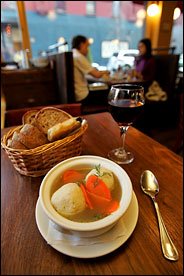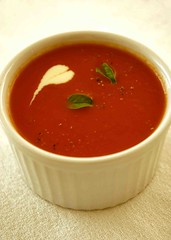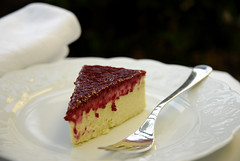 One more post about soup and I’m done. It’s enough, I know, but this last one is important so the soup trilogy will be completed.
One more post about soup and I’m done. It’s enough, I know, but this last one is important so the soup trilogy will be completed.In Brazil chicken soup is called “canja de galinha”. Besides the soup we also say something is “canja de galinha” when it is very easy to do. Ok, it’s easy, but a chicken soup has to be well done to be flavorful, light, fulfilling and restorative at the same time. The soup is commonly used to help people overcome colds and digestive problems. I always make myself a chicken soup when I’m not feeling very well and many times I woke up cured next morning. Of course chicken soup is a comfort food and we know they can make us feel better, but it is more than that…
According to food historians chicken soup was prescribed as a cure for the common cold in Ancient Egypt. Avicenna, the Persian physician who is considered by many the father of the modern medicine, referred to the curative powers of chicken soup in his writings and strongly recommended it as did the rabbi and Jewish doctor, Maimonides. Today, researches of the University of Nebraska suggest that there might be some scientific basis for the belief in the curative powers of chicken soup. The blend of nutrients and vitamins in traditional chicken soup can slow the activity of certain white blood cells, possibly producing an anti-inflammatory effect that can ease the symptoms of the illness. Also the simple fact that the soup is nutritious and easy to digest makes it very valuable for the convalescents, as they don’t have to spare more energy than necessary on digestion saving it to fight the disease. Some say that sipping warm soup can also clear the sinuses because of the steam ventilating into the nasal passages, serving as a natural decongestant which also relieves cold and flu symptoms.
When I do mine I don’t measure anything so no soup is like other and it’s impossible to write a recipe. But the ingredients are mostly the same every time: olive oil, chicken legs and thighs, carrots + celery + tomato + onion (all diced) garlic + ginger + scallion + cilantro + parsley (all minced). And what I do is sauté the chicken in the olive oil, add all the other ingredients but the herbs, sauté for a couple of minutes, add boiling water and let it cook until the chicken is cooked and falling apart from the bones. Then I add the fresh herbs, take the chicken out, shred the meat, put the pieces back in the soup and serve it very hot.














